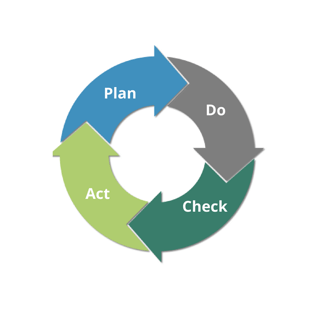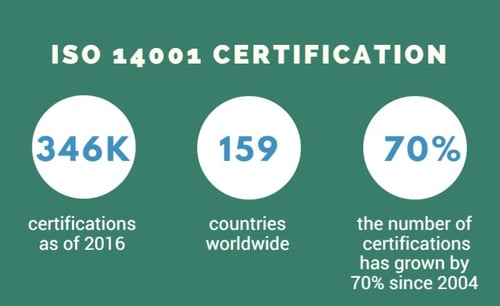ISO 14001 Environmental Management
GUIDE
The Definitive Guide to ISO 14001 Environmental Management
This page will give you an overview of ISO 14001 environmental management, including what it is, the benefits, what’s in the 2015 revision, how to implement, and FAQs.

What is ISO 14001?
ISO 14001 is an international standard that outlines requirements for an environmental management system. It provides businesses with a framework to continually improve their environmental performance in order to cut costs, reduce waste, and show management and stakeholders that they are growing sustainably.
Table of Contents:
(If you want to learn more about our environmental software solutions, visit our environmental management system software page.)
Introduction
Managing your environmental responsibilities can be a tough task. Not only do you need to be able to show progress to your managers, you also need to prove your environmental commitment to your customers and investors.
It’s hard to balance these demands, but ISO 14001 environmental management can go a long way to helping you minimize your impacts and grow sustainably.
Free Resource: ISO 14001 Implementation Checklist
Whether you’re implementing ISO 14001 for the first time or transitioning to the new version of the standard, this page will give you an overview of ISO 14001 environmental management.

Benefits of ISO 14001
As we said before, ISO 14001 environmental management can go a long way to helping you minimize your impacts and grow sustainably. Here are some of the main benefits of ISO 14001:
- Comply with legal obligations: The ISO 14001 framework provides a centralized way to track your organization’s environmental performance.
- Meet stakeholder expectations: Customers and shareholders are demanding higher environmental standards from the companies they support. ISO 14001 can your company communicate their commitment to the environment.
- Engage employees: Getting employees involved in environmental initiatives can be challenging, but ISO 14001 offers a way to show employees that they’re making a difference.
- Gain a competitive advantage: Third-party certification can distinguish your company from your competitors. It can even provide a financial benefit by helping you reduce waste and use resources efficiently.
Environmental management systems
An environmental management system (EMS) is a set of planned, documented processes for managing and improving your environmental performance. Like a playbook, it contains your environmental strategies and actions yet offers the flexibility to respond to changing situations.
An ISO 14001 EMS should follow the Plan > Do > Check > Act structure being implemented across all ISO standards.
What is Plan > Do > Check > Act?
Plan > Do > Check > Act is a model for continuous improvement.
-
Plan: Develop a high level understanding of key environmental issues and stakeholder needs, then plan actions to address risks and opportunities.
-
Do: Test the plan and track performance indicators.
-
Check: Perform internal audits to assess the effectiveness of the system.
- Act: Address any issues found in your audits. Use what you learned to plan new improvements as the cycle starts again.

ISO 14001 requirements
Although all ISO 14001 EMS’s follow a similar Plan > Do > Check > Act structure, companies identify their own goals and areas of improvement.
Since there are no specific requirements for environmental performance, ISO 14001 can be implemented in any organization, regardless of your size, industry, or current performance.
Below, you’ll find a broad overview of the ISO 14001 requirements:
-
Context of the organization: Determine who you are, what you do, who cares about you, and how you will respond.
-
Leadership: Secure leadership commitment and define an environmental policy.
-
Planning: Plan actions to address risks and opportunities, and to achieve environmental objectives.
-
Support: Identify your resources, communication, and documentation for your EMS.
-
Operation: Define operational controls and how you will respond to emergencies.
-
Performance evaluation: Determine how you will monitor, measure, analyze, and evaluate your EMS, including internal audits.
-
Improvement: Determine how you will deal with nonconformity, including corrective actions, as well as continual improvement actions
What’s new in the ISO 14001:2015 revision?
The new ISO 14001 revision, published in 2015 encourages businesses to put sustainability at the center of what you do. It also aligns ISO 14001 with other standards like ISO 9001 to make it easier for businesses to manage everything in one place.
Key improvements include ensuring that environmental issues are addressed in strategic planning, considering the entire lifecycle of a product, and communicating transparently with suppliers and customers.
Watch our joint webinar with Trinity Consultants, “ISO 14001:2015: Managing Compliance with the Standard”.
Getting started with ISO 14001
Whether you’re just getting started with the ISO 14001 standard or transitioning to the 2015 version, there are a few critical first steps that can help ensure a smooth transition:
-
Secure buy-in from senior management.
-
Get a big picture overview of existing processes and systems around your environmental impact.
-
Define your goals.
ISO 14001 certification
After implementing ISO 14001, many companies choose to pursue third-party certification.
Although certification isn’t required, it offers several benefits. Apart from the benefits of having a structured environmental management system, ISO 14001 certification provides a solid demonstration of your business’ commitment to the environment.

(Source: International Organization for Standardization)
Environmental management software
Naturally, keeping track of all the information you need for compliance or certification can be overwhelming. An environmental management information system (EMIS) can help you wrangle your overall environmental management system.
While it’s possible to use several different software programs to manage your EMS, a centralized environmental management software can cut your workload in half.
Environmental management software keeps track of your air, GHG, water, and waste data in one central location.
It allows you to automate reminders, perform day-to-day tracking tasks, and create reports to show managers the “big picture”. This saves loads of time when pursuing certification.
Custom EMIS software
EMIS software can be purchased commercially or built in-house.
Frequently asked questions
How long does it take to implement ISO 14001?
The short answer is, it depends. The time it takes to implement ISO 14001 depends on the size of your organization, what resources you have available, and how familiar you are with the standard. It might only take 6 months for small companies, while large companies may take a year or more.
How much does an environmental management system (EMS) cost?
An “environmental management system” is a pretty generic term, and the price will vary significantly depending on your needs.
A small company might only spend $10,000, while a larger organization might spend well over $100,000 after consultants, auditors, etc. That said, an effective environmental management system can help your company reduce waste, save energy, and avoid costly fines.
Regardless of your industry and your budget, the cost of an effective environmental management system is a drop in the bucket compared to your potential savings.
Can’t I just use spreadsheets to track ISO 14001 information?
We can’t stress enough how important it is to use environmental management software. Not only do spreadsheets pose a major data security risk, but the “do-it-yourself” approach can be a huge time suck.
Here are some of the problems with cobbling together an environmental management system:
-
You’ll be stuck entering data multiple times, which can lead to errors.
-
It’s easy to miss important deadlines without a system for reminders.
-
Pulling data into a report from multiple spreadsheets can take days or weeks.
-
If you need to collect data from multiple sites, you’ll have to travel there and then return to your office to enter all the data.
I’m already using ISO 14001:2005 — how soon do I need to transition to ISO 14001:2015?
Companies have until September 2018 to transition to the new standard. After that date, ISO 14001:2004 certificates won’t be valid.
Do I need to hire an ISO 14001 consultant?
Many companies achieve ISO compliance or certification on the own, but a knowledgeable consultant can get you through the process much faster. Not only are consultants experts on the ISO standard, but the “do-it-yourself” approach can spread your resources too thin and end up costing you in the long run.
Bonus: 14001 Checklist for Success
We’ve given you a lot to digest. But if you’re serious about getting your organization set up with a solid environmental management system, the next step is to download our free ISO 14001 implementation checklist using the form below.
We’ll give you an overview of what’s involved and make sure you don’t miss any steps in your implementation. (You can even share the guide with your team or management!)